#uiowaspecialcollections
Explore tagged Tumblr posts
Text
Voices From the Stacks: Corita Kent

Collage of Corita Kent from the Josephine Pletscher Papers (IWA0913)
Corita Kent was an American artist, educator, activist, and former religious sister. With a rebellious spirit, Corita was a pioneering designer, who produced a body of work for over three decades combining themes of spirituality, hope, peace, and acceptance. Inspired by the popular Pop Art movement taking hold throughout the 1950s–60s in America, Corita’s serigraphs, also known as screenprints, incorporated questions about racism, war, poverty, and religion through found text, images, and vibrant colors.
Corita, born Frances Kent in Fort Dodge, Iowa, in 1918, grew up in Los Angeles after her family relocated there when she was a young child. At 18, Corita decided to join the order of the nuns at the Immaculate Heart of Mary, providing her the opportunity to pursue art and higher education in a way that would not have been an option for many women in 1936. While here, she took the name Sister Mary Corita though wished to be referred to as Corita. As a member of the teaching order, she taught art education at various institutions while receiving an art education herself. In 1947, Corita was then asked to teach with the Art Department at the Immaculate Heart College where she would remain until 1968.


Corita Kent with her students at Immaculate Heart College from Sister Corita
The Art Department at Immaculate Heart College was a space of growth and development for Corita. Here she would develop her art style, which in early stages often incorporated religious imagery, containing medieval-influenced figures, then later evolving to integrate a wider breadth of material like song lyrics, advertisements, abstract shapes, and brighter colors. While Corita was further developing her work, she was having a significant impact on her students, urging them to discover new ways of experiencing the world. Through exercises like exploring a grocery store for inspiration or looking through an empty 35mm slide mount to frame compositions, Corita’s approach to teaching inspired her students and led to a fruitful period of creation and exploration for Immaculate Heart College which drew national recognition. This influential impact can be seen in the work of Corita’s students of this time, found within the student’s pieces, as well as the Irregular Bulletin, a zine-like newsletter created by the art department to announce the activities and accomplishments of students and faculty.


Pages from the Irregular Bulletin, created by the Art Department under Corita Kent’s direction
Through rising tensions within the country from the United States' involvement in the Vietnam War, Corita and her fellow sisters became more politically and civically engaged, participating in demonstrations throughout the city, and gaining a reputation as rebellious nuns. By 1968, the strain between the Immaculate Heart of Mary sisters and the Archbishop of Los Angeles was high, leading to the majority of the sisters dispensing with their vows, and Corita leaving LA for the East Coast. It was there Corita would continue to create under a more introspective style until her passing in 1986.


Left, Immaculate Heart nuns protesting at a Mary’s Day Procession in 1964 (Courtesy of Corita Art Center). Right, A postcard with an image from the same protest included with prints from Damn Everything but the Circus.
Within the University of Iowa’s collections, Corita’s work can be found through various published books, screenprints found both in the Special Collections and Archives as well as the Stanley Museum of Art, and an intimate manuscript collection from a former student, her mentee and friend, Josephine Pletscher. Pletscher, with a long-lasting connection to the Immaculate Heart College, amassed a thorough collection not only regarding the Immaculate Heart but also Corita and her career. Incorporating correspondence, serigraphs created both by Pletscher and Corita, as well as Corita’s personal rosary beads, the care and connection between the two women is evident.
With impactful messages that continue to resonate today, Coritas work reminds viewers to reflect upon and explore the world around them. Just as she imparted to her students, great strength comes from opening oneself to new possibilities.

Published books featuring Corita Kent’s art found in the Sackner Archive of Concrete & Visual Poetry.
To learn more, visit us in person to view the published Corita Kent printed materials within the collection, or visit the finding aid for the Josephine Pletscher Papers (IWA0913) which can be viewed in person at the Iowa Women’s Archive. Additional information about Corita and her work can be found at Corita.org.
-Kaylee Swinford, Olson Graduate Research Assistant
#uiowa#libraries#special collections#rare books#uiowaspecialcollections#voicesfromthestacks#corita kent#sister corita kent#immaculate heart of mary
54 notes
·
View notes
Text
#MiniatureMonday #TinyTuesday
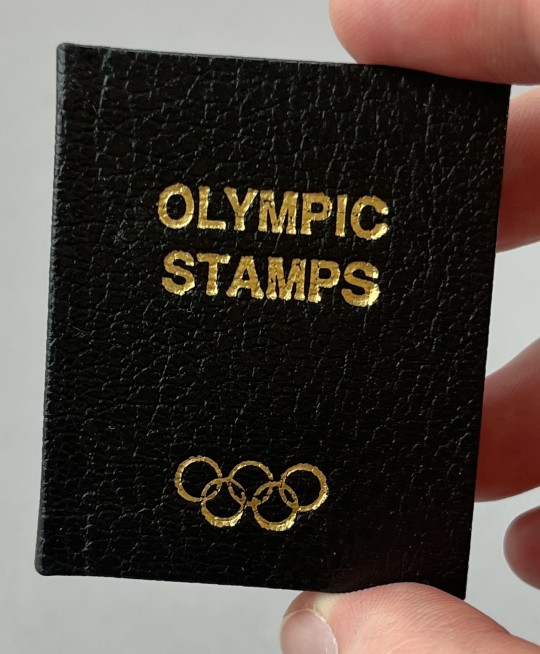
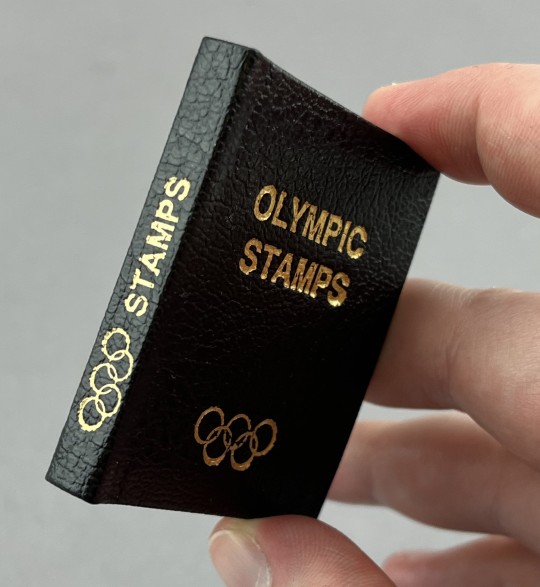
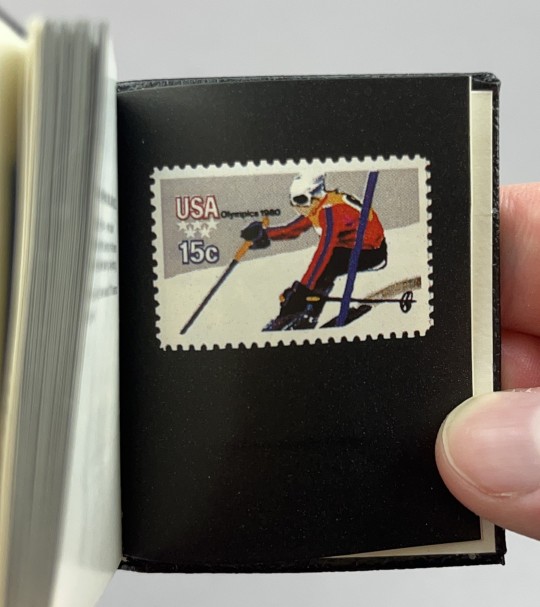
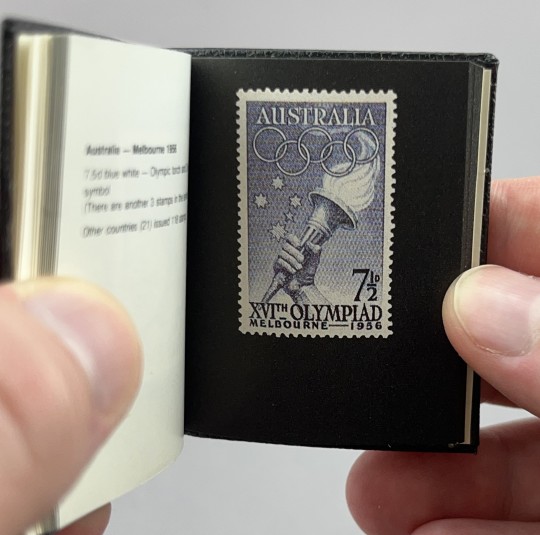
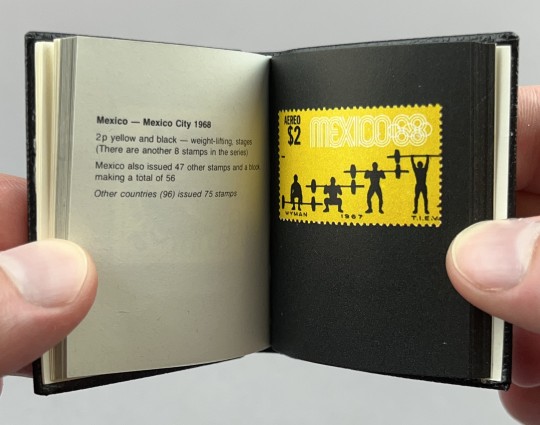
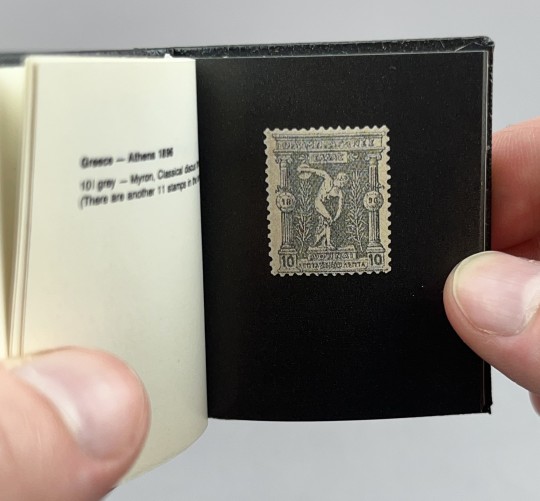
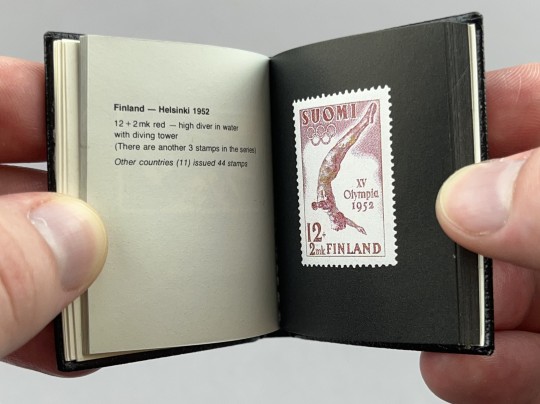
Olympic stamps / [edited by Kazimir Rapoša ; text by Tomaž Zajc ; translated by Martin Cregeen].
In honor of the upcoming summer Olympics, we here at Special Collections and Archives thought it would be fun to take a look back at previous Olympics through the miniature book Olympic Stamps! This book contains Olympic stamps dating all the way back to the 1800s.
Spanning many countries, including Finland, Mexico, and of course Greece. These stamps perfectly encapsulate their hosted summer or winter Olympics.
So take a look at these awesome stamps and get excited for the upcoming events (and hopefully a new, amazing stamp)!
-- Adair J
#uiowa#special collections#libraries#miniaturemonday#rare books#miniature books#olympics#uiowaspecialcollections#stamps
165 notes
·
View notes
Text
Top 10 Pacific Islands Materials in Our Collection
While Pacific Island cultural experiences are far and few in Iowa, Special Collections & Archives is the proud host of a number of rare and highly regarded publications by prolific Pacific Islander creators or about the rich histories and cultures of the islands!
Te Kuia me te Pungawerewere (The Kuia and the Spider) by Patricia Grace.


(X-Collection Folio PZ5.G73 K85 1981, X-Collection FOLIO PZ5.G73 K853 1981)
Patricia Grace’s Māori children’s book, Te Kuia me te Pungawerewere, it’s English language version titled The Kuia and the Spider, is the tale of a Kuia, meaning elderly woman or grandmother in English, and a spider who share a kitchen and are in a constant playful argument of who is better than the other. Patricia Grace, a former school librarian herself, is a famed Māori writer of novels, short stories, and children’s books. The publication of this book in both English and te reo Māori, the Māori language in the 1980s was of great importance to language revitalization efforts following the presentation of the Māori Language Petition in 1972 and the officialization of Māori Language Week in 1975. Te Kuia me te Pungawerewere was awarded New Zealand Picture Book of the year in 1982 and remains a beloved story by Māori educators and families.
Tongan Ngatu.


(MsC 913)
Ngatu, or ngatu hingoa, in the Tongan language refers to the elaborately decorated tapa bark cloth tapestries of Tongan cultural significance. The art of ngatu is made distinct through processes of dying, stamping, and hand painting the tapestries, though still similar to the artful practices using tapa bark cloth in other Polynesian islands. The ngatu held in Special Collections was likely created in the 1940s, during or after World War II, and includes illustrations of planes to commemorate the contribution of the Tongan Defense Force to the British war effort. The tapa, or bark cloth itself, is likely made from mulberry tree bark, commonly used in the Pacific for this exact craft. Illustrations and stamping was likely done with dyes made from saps of other native Tongan plant species, such as candlenut trees.
Roma Potiki by Roma Potiki.
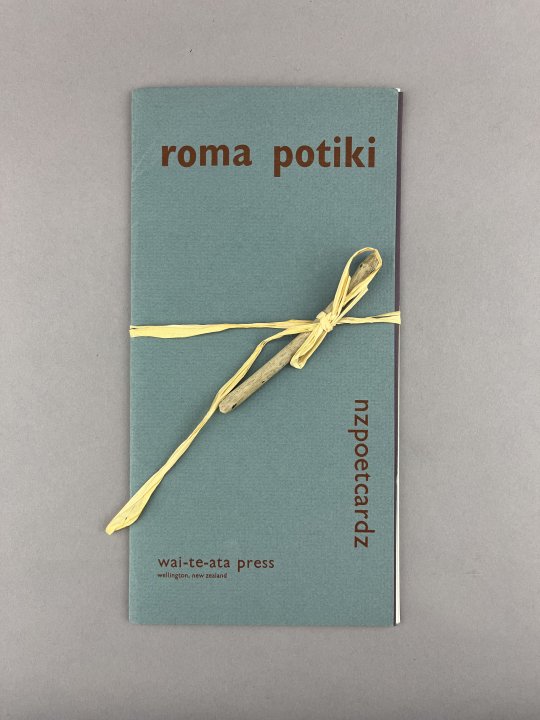

(X-Collection Folio PR9639.3.P59 R6 1996)
Roma Potiki is a noteworthy contemporary Māori poet, playwright and performer. Her self titled collection of poetry explores themes and topics of nature, the human spirit, Māori womanhood, politicization, and the lasting effects of colonization. The poems in this limited collection were also published in her 1998 collection, Shaking the Tree.
Death and the Tagua by Alistair Te Ariki Campbell.


(X-Collection Folio PR9639.3.C275 D4 1995)
Alistair Te Ariki Campbell is famed New Zealand poet and playwright of Cook Islands Māori descent. This collection of poems, Death and the Tagua, is the artistic account of and response to Campbell’s own journey from Rarotonga in the Cook Islands to New Zealand via a Tagua sailing vessel, and the deaths of both of his parents in his early life. More information about the Death and the Tagua can be found in our YouTube series, Nibbles of Knowledge.
Tapa: the bark paper of Samoa and Tonga by Lilian Bell & Ulista Brooks.



(Smith Miniatures Collection TS1095.S36 B45 1979)
Tapa is the bark paper or cloth of Polynesian islands including Samoa and Tonga, as specifically shown in this miniature book of paper samples. The bark of mulberry trees among other plants is processed into a fibrous paper, that is often then ornately decorated with dyes for cultural customary or celebratory purposes. In Tongan culture, these decorated tapa are called ngatu, and in Samoan culture, called siapo.
Whanau by Witi Ihimaera .


(X-Collection PZ5.I35 W43 1974)
Whanau, meaning family in te reo Māori, is a story of just one day in the lives of a large family living in a rural Māori village, struggling with the loss of traditional values and ways of living due to colonial pressures. It is the second work published by Witi Ihimaera, who is considered one of if not the most influential Māori writer still today. He was the first Māori writer to ever publish both a novel and book of short stories. The story takes place in the small town of Waituhi, were Ihimaera himself was raised and inspired to become a writer after seeing the erasure or mischaracterization of Māori in literature in New Zealand and globally. Our copy is signed by Ihimaera, with a note to the book’s donor, Carmon Slater, that reads “To remind you of a wonderful partnership and warm time at Tokomaru Bay when we worked on improving the self image of Māori Children.”
Ethnic Foods of Hawai’i by Ann Kondo Corum



(Szathmary Collection TX724.5 .H3 C68 1983)
Ann Kondo Corum, formerly a school librarian in Honolulu, wrote and illustrated Ethnic Foods in Hawai’i to provide a sense of history and culture through the foods and cooking traditions of the now multi-racial state of Hawai’i. She saw a need for this during her time as a librarian, when students had trouble finding information about the foods and culinary customs of their peers. This cookbook dives into the history and popular traditional recipes of the major cultural groups on Hawai’i, including traditional Hawaiian and Samoan recipes, celebrations, and culinary customs.
Māori Legends illustrated by Manu Smith.


(Smith Miniatures Collection GR375 .M36 1993)
This miniature book is the illustrated telling of major Māori legends or oral histories, including those of Maui, Pania, and Rona, the woman who went up to the moon. Illustrations are done by Manu Smith, who is also known for having illustrated Māori legends series for New Zealand stamps and phone cards in the 1980s and early 2000s.
Standing Place by Fred Hagstrom.



(X-Collection Oblong N7433.4.H25 S73 2012)
Fred Hagstrom is an artist and Professor Emeritus of Art and Art History at Carleton College in Minnesota. Standing Place is an artistic telling of a story about shared culture and the soldiers of the Māori Battalion during World War II. This covers the story of Ned and Katina Nathan, who are also the focus of Patricia Grace’s book, Ned and Katina. In his artist statement on the piece, Hagstrom writes: "I take students to New Zealand every two years, and in doing that have made good friends at a Maori Marae, which is a tribal meetinghouse. This is the story of their parents. … They also founded the Marae that I visit. This book is made in the friendship I feel for this remarkable family." The Marae in mention is the Matatina Marae at Waipoua. The kawai pattern on the book’s cover, titled Tatai Hono (the joining of lines of descent) was designed by Manos Nathan, son of Ned and Katina.
Francis Wherahiko Rawei, from the Redpath Chautauqua Bureau Records



(MsC0150 Box 238, Box 272)
Francis Rawei, also known by his former name Wherahiko Rawei or his stage name Dr. Rawei, was a Māori performer and educator of the early 20th century. Alongside his wife Hine Taimoa, a lecturer, harpist and singer herself, he toured internationally lecturing, singing and story-telling about Māori history, life and culture. Together they toured the United States and Canada on the Chautauqua circuit and lived briefly in Chicago before eventually returning to New Zealand.
Also worth mention are the many travel diaries and publications collated by some of the first foreign seamen to arrive in the South Pacific. I have very intentionally not included any of these materials, as these diaries are predominantly accounts of travel to these islands with the goal of imperial conquest or religious purification of Indigenous Pacific Islanders, and unfortunately are not without deeply racist and offensive language. This undoubtedly makes these materials challenging to read and engage with, but the effects of colonialism and religious missionary efforts are very real and prominent parts of Pacific Islands history, as well as our present day. Their place in a rare book repository is just as important to the preservation of Pacific Islands history and culture as those included on this list.
--M Clark
#special collections#uiowa#miniature books#rare books#uiowaspecialcollections#libraries#maori#pasifika
27 notes
·
View notes
Text
#MiniatureMonday
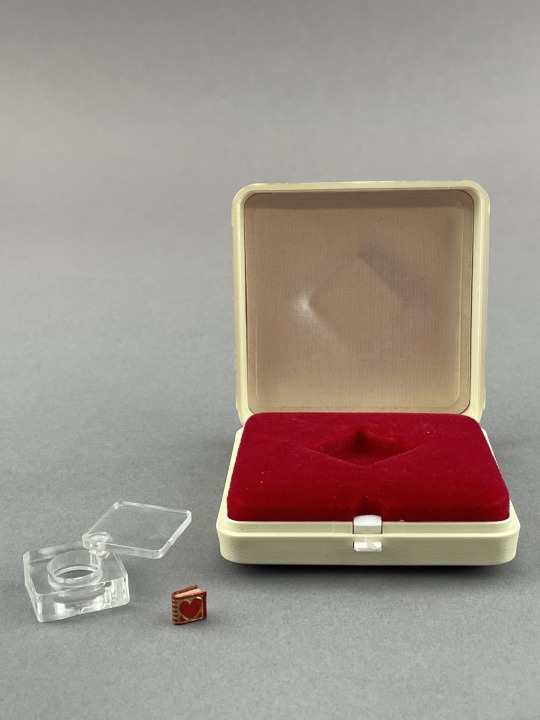
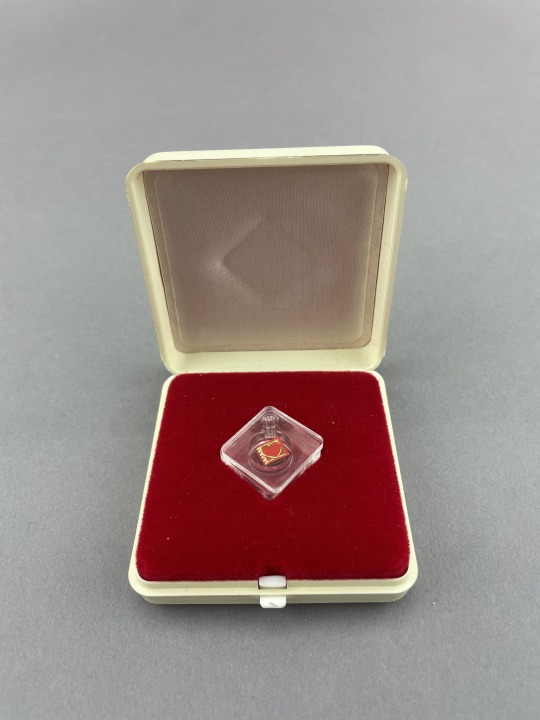

Serments d’Amour
Measuring 6mm, this micro book is one of the smallest in the collection. Serments d’Amour (roughly translating to ‘Love Oaths’), features the phrase “I Love You” in 8 different languages. The little book is bound in red leather with a stamped golden heart on the front cover, featuring golden gilded edges. The copy was issued in a cream case with a red velvet cushion and a small, magnified case to help see the finer details.
Je t'aime -- I love you -- Ich liebe Dich -- Ti voglio bene --我爱你-- Я тебя люблю-- أحبك --te amo --te quiero
#uiowa#special collections#miniaturemonday#uiowaspecialcollections#miniature books#miniature monday#French#german#italian#russian#chinese#arabic#english#spanish#microbook
215 notes
·
View notes
Text
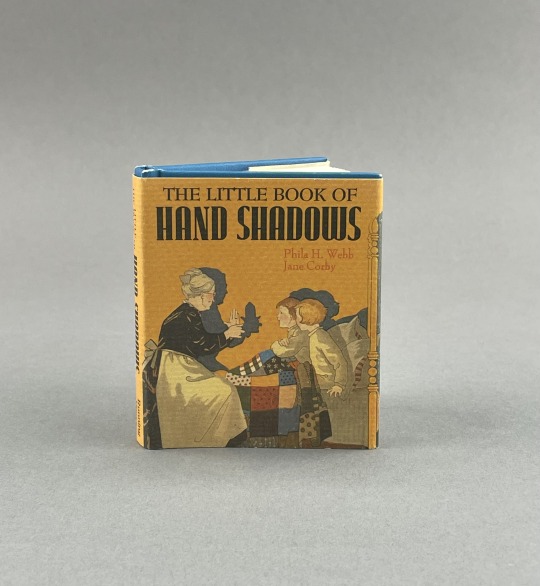
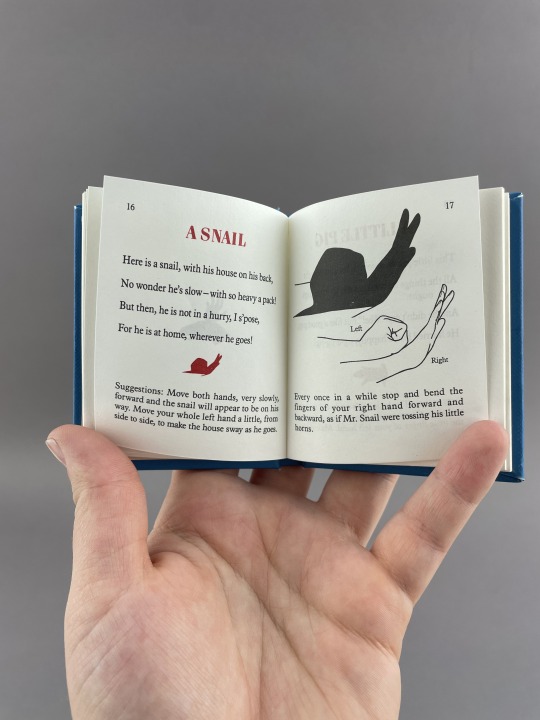
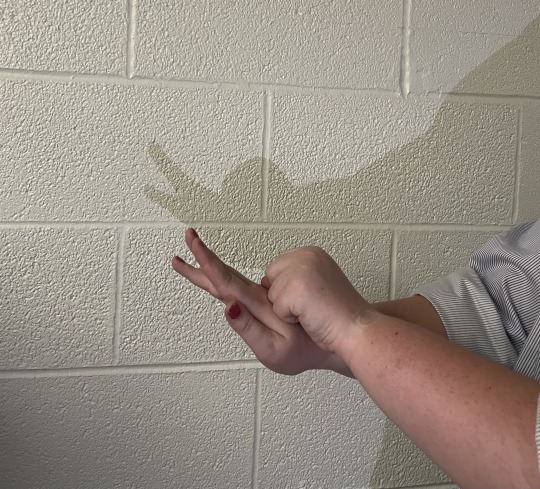
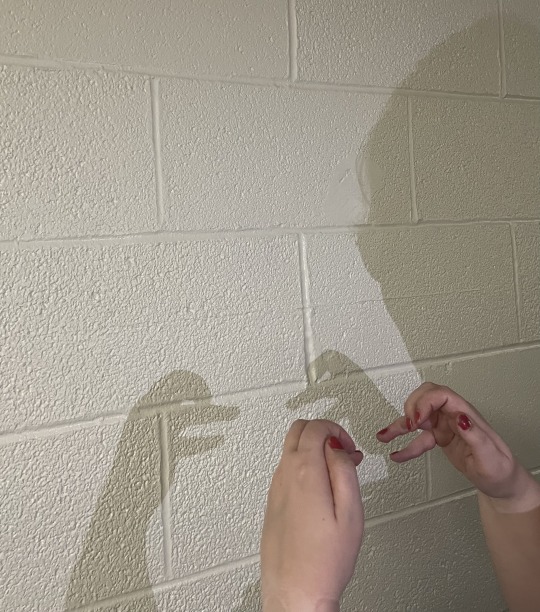
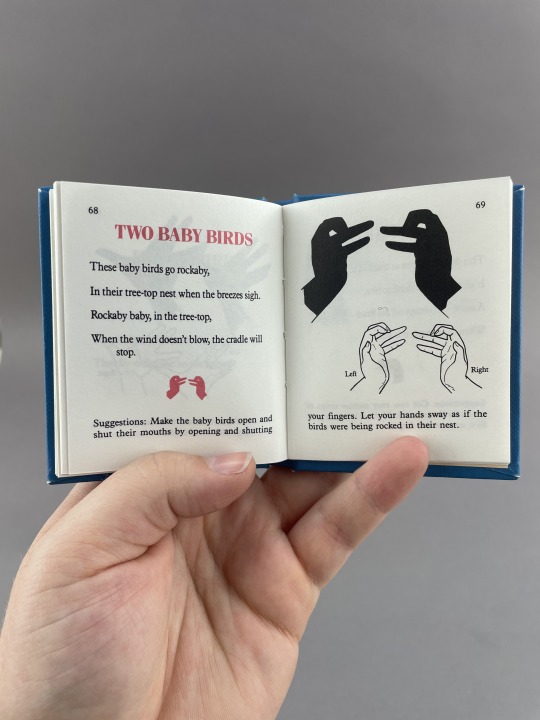
#MiniatureMonday
The Little Book of Hand Shadows
“Discover the timeless magic of hand shadows through this charming volume” - Dust Jacket
This little pocket-sized book, created and drawn by Phila H. Webb with verses by Jane Corby, is reprinted and adapted from the original “Shadowgraphs Anyone Can Make” from 1927. With the help of a bright light, a blank wall (or sheet as the book suggests), and two hands, various characters and creatures can be projected, solidifying the simple entertainment and joy of shadow puppetry.
According to Phila, some of the poses may take more practice to perfect, but there is “nothing hard about any of them”. To test this, I had a self-proclaimed shadow puppet enthusiast try out some of the poses, following the instructions from the text. How do you think they did?
-Kaylee S., Olson Graduate Assistant
-Sarah D.., Illustrious Hand Model
#uiowa#special collections#miniaturemonday#uiowaspecialcollections#miniature books#history#miniature monday#library#shadow puppets#puppetry#Phila H. Webb#Jane Corby#shadowgraphs
174 notes
·
View notes
Text
#VoicesFromTheStacks

Image: Self Portrait with cranes from Hope Project (Photo credit: Clarissa Sligh)
The Artist Books of Clarissa Sligh
In honor of Black History Month, we are highlighting artist, writer, and lecturer Clarissa Sligh. Born in Washington, D.C. and raised in Virginia, Sligh is often inspired by cultural, historical, and political events that intersect with moments in her life. Sligh considers these interactions, or “collisions,” between moments in history and events in one’s life to be significant and transformative. One such example of this is detailed in Sligh’s work “It Wasn’t Little Rock,” which discusses desegregation in public schools during the 1960s, a personal topic for Sligh, who was the lead plaintiff at the age of 15 in a school desegregation case.
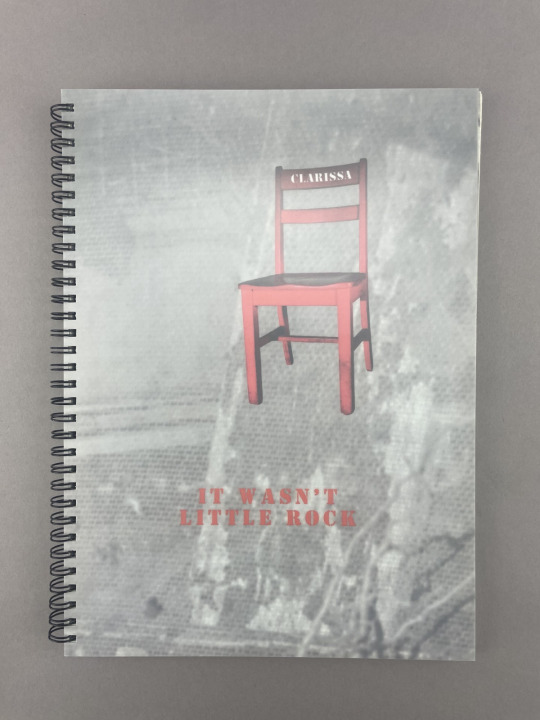
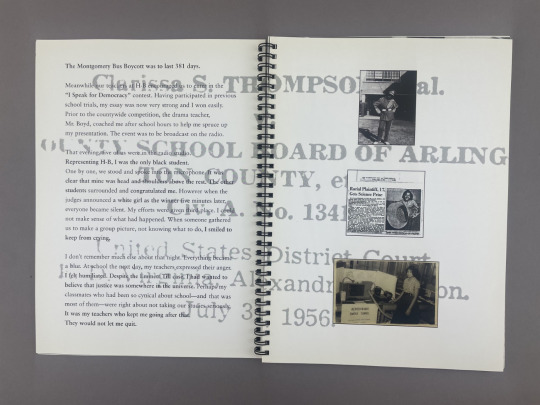
Images: Cover and inside page of "It Wasn't Little Rock" (2005)
A notable example of Sligh’s work and its reference to her personal experiences is her 1988 artist's book titled “What’s Happening with Momma?” Here, the artist engages users to “walk” through rooms of her childhood home, following the steps of accordion-folded strips of paper filled with text detailing memories of her sister’s birth in the home. This is Sligh’s first artist’s book, made through the Women’s Studio Workshop in New York.

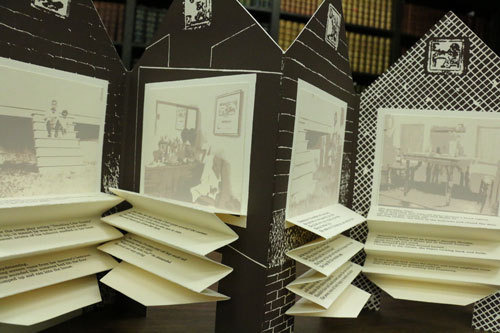

Images: Cover and inside page of "What's Happening with Momma" (1988)
Sligh earned a BS in Mathematics from Hampton Institute in Virginia, a BFA and an MFA in visual arts from Howard University, and an MBA from the University of Pennsylvania. Earlier in her career she had worked at NASA in the manned space flight program, eventually leaving to focus on working as an artist. Her works have been featured all over the world, notably at the Museum of Modern Art in New York, the National Museum of African American History and Culture, and more. To learn more about Sligh and her works, visit the artist’s website.
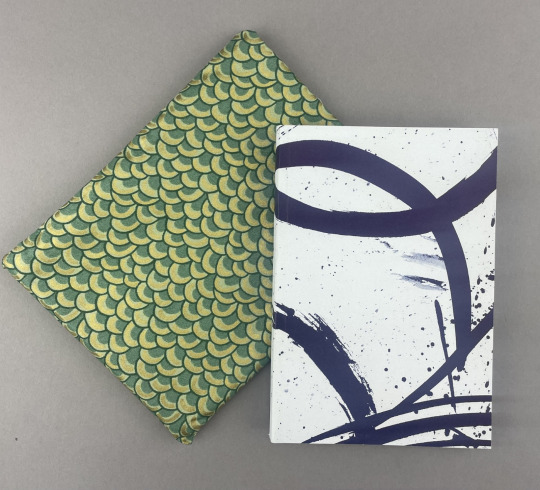

Images: Cloth enclosure, cover and inside page of "Voyage(r): A Tourist Map to Japan" (2000)
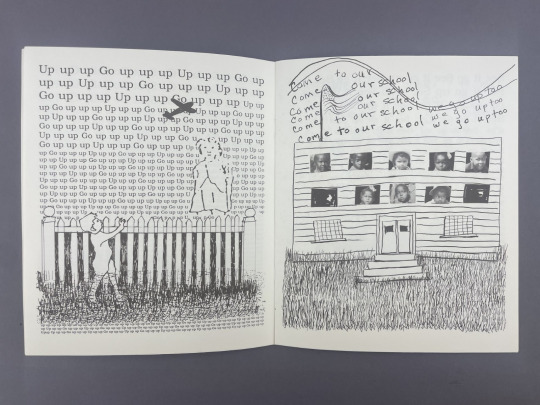

Images: Left: Inside page of "Reading Dick and Jane with Me" (1989). Right: Cover and origami crane for "Transforming Hate" (2016).
– Kaylee S., Special Collections Olson Graduate Assistant
#uiowa#libraries#special collections#uiowaspecialcollections#rare books#voicesfromthestacks#artist books#Clarissa Sligh#black history month
73 notes
·
View notes
Text
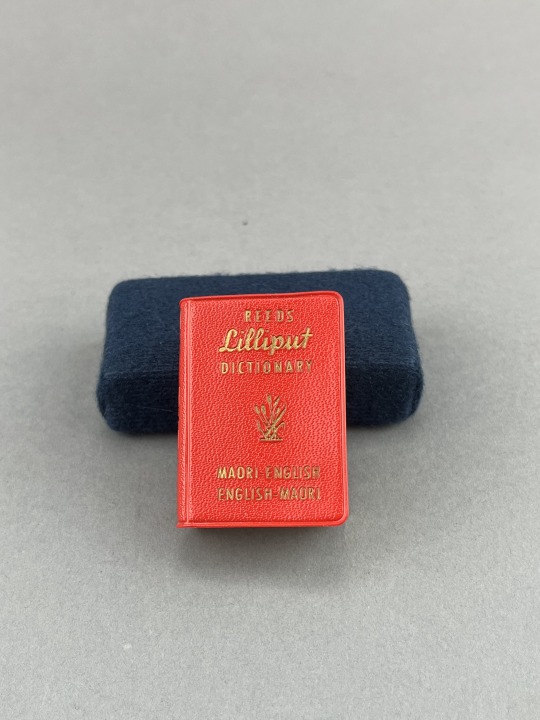

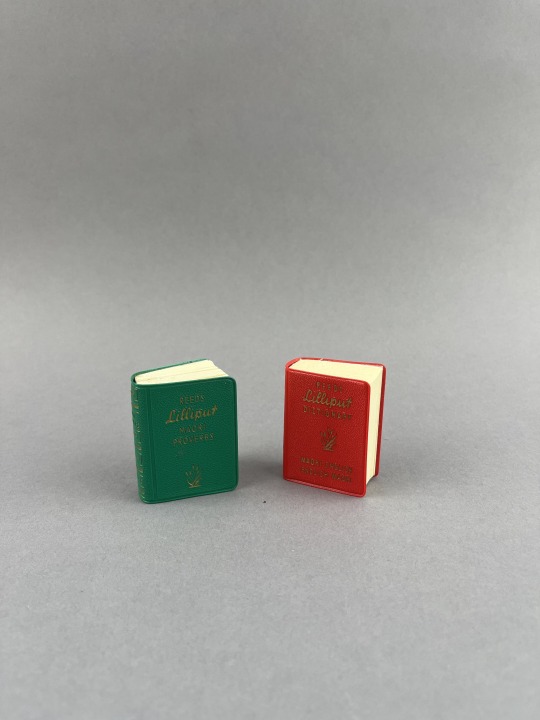
#MiniatureMonday
Happy Māori Language Week from Special Collections & Archives!
Te Wiki o te Reo Māori, Maori Language Week, is celebrated annually the week of September 14th to commemorate Te Wā Tuku Reo Māori, the Maori Language Moment, which stamps the presentation of the Maori Language Petition in New Zealand at 12 pm on September 14, 1972.
Te Reo Māori is the language of New Zealand's Indigenous Maori people. It is a part of the Austronesian language family and shares its roots with other island languages including Tahitian and Hawaiian. The celebration of Te Wiki is rooted deeply in efforts to revitalize the Māori language after years of the speaking and use of te reo was banned in schools. Today, te reo Māori is the official language of New Zealand, or Aotearoa as it is called by the Indigenous people. It has become increasingly used in New Zealand society, culture, and professional institutions. The Māori language has also become something of global interest, with the popularization of the language through its presence in music, film, television, and sports commentary.
In the United States, Polynesians as a whole make up less than half of a percent of the American population, with Māori people as one of the smallest migrant populations. Still, for those living abroad or interested in learning the language from afar, the language revitalization movement has certainly spread to the United States, along with its learning materials and resources.
There is a Māori proverb that reads ahakoa he iti he pounamu, "although it is small, it is greenstone." This refers to the importance of things small but precious, such as these miniatures!
The Reeds' Lilliput Māori dictionary and Reeds' Lilliput Māori proverbs live in Special Collections as part of the Smith Miniature Book Collection. These 5cm tall miniature books were published by A.W. Reed in the early 1960s, the dictionary in 1960 as part of a collection of miniature dictionaries made popular by other global publishers. The book of whakatauki, Māori proverbs, joined the mini-dictionary in 1964. Other language dictionaries include Spanish, French, and Romanian. Due to their size, it is likely that these books were made to entertain more so than educate. Still, they are certainly one of the many taonga, treasures, of Special Collections.
Te Wiki o te Reo Māori 2023 begins Monday, September 11, and concludes Sunday, September 17. Celebrate through songs, stories, conversations, or by learning some library-related Māori vocabulary! You can also visit the University of Iowa LibGuide on learning beginner's te reo Māori.
NGĀ KUPU WHARE PUKAPUKA LIBRARY VOCABULARY
pukapuka book
pūranga archive
whakaputunga collection
kaitiaki pukapuka librarian
wāhi tuku pukapuka reference desk
pānui to read
ako to learn
--From M Clark, Instruction GA
Reeds' proverbs (SMITH PL6465.Z77 .R44 1964) and Reeds' dictionary (SMITH PL6465.Z5 .R44 1960)
#uiowa#special collections#miniaturemonday#uiowaspecialcollections#rare books#library#maori culture#te reo maori#proverbs#new zealand
86 notes
·
View notes
Text
#MiniatureMonday #TinyTuesday!
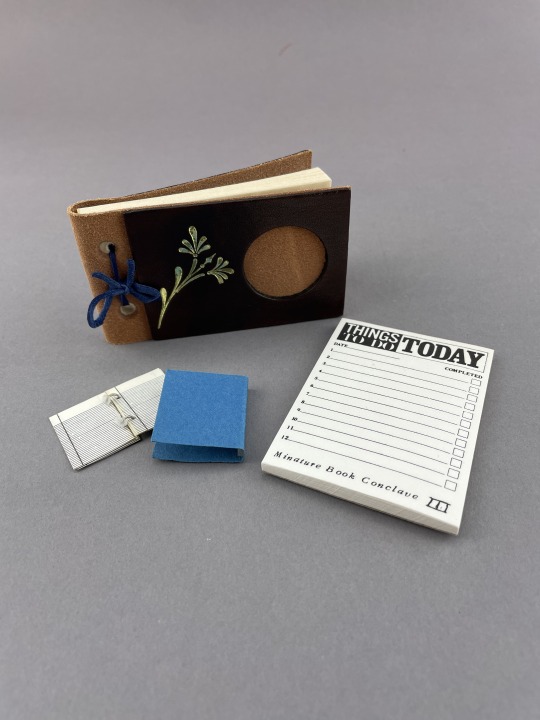
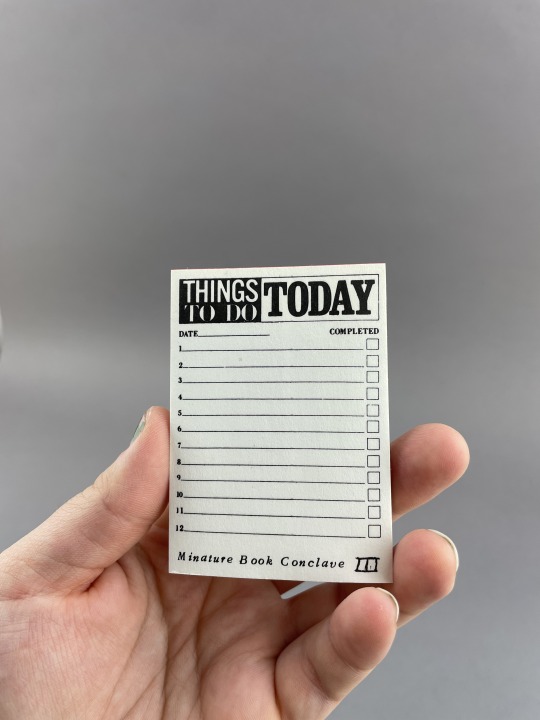
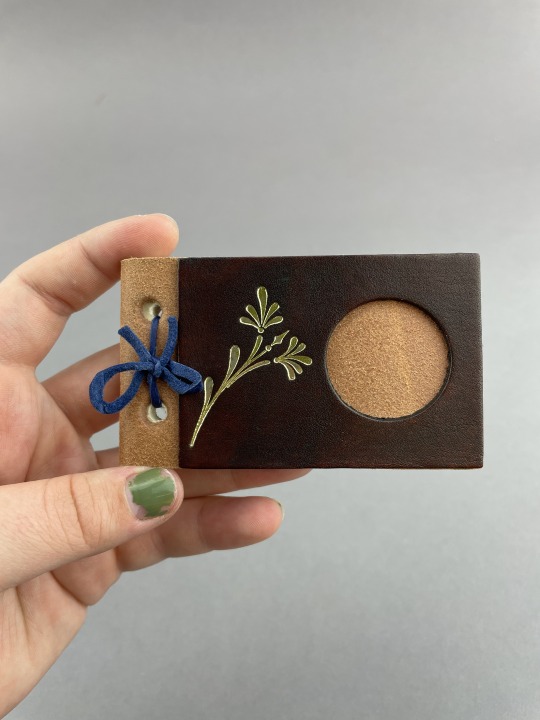
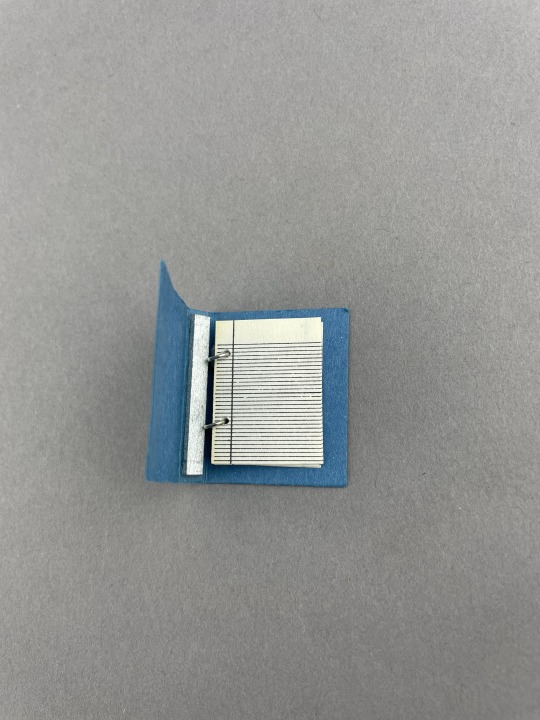

School Supplies
I think we all can agree that one of the best things about going back to school is new supplies! Whether it be notebooks, planners, pencils or pens, there is nothing quite like finding the perfect new things to carry you through the school year. Here are some minis that are perfect for the start of the new school year.
The first miniature is five leaves of blank notebook paper attached to metal rings, perfectly sized to fit inside the blank blue binder. The creator of this binder is not identified, but I like to think they made this little binder to send their mouse friend off to school with.
Next is a beautiful handmade notebook bound in soft brown leather with a gilt flower design stamped into the front cover. With lovely blank cream paper inside, this notebook is the perfect handheld size to carry around and jot down thoughts as they arise.
Originally made for the third Miniature Book Society Conclave held in LA in 1985, our third mini is a daily planner. With “Things to do today” printed largely at the top and a numbered checklist on the page, this would be an excellent way to keep your day organized!
-Kaylee S., Olson Graduate Assistant
Charlotte Smith Miniature Collection
TS1250 .T45 1985
TS1250 .M56
TS1250 .B53 1900z
#uiowa#miniaturemonday#history#library#special collections#miniature books#UiowaSpecialCollections#notebook#planner#artist books
74 notes
·
View notes
Text
#VoicesFromTheStacks

Image: Oscar Hahn from La Tercera
Oscar Hahn
Oscar Hahn, born in Iquique, Chile in 1938, began writing poetry early in life. The first book of poetry Hahn published, Esta Rosa Negra, in 1961, included poems he had written between the ages of 17 and 19. Once graduated from the University of Chile in 1963, Oscar attended the International Writing Program at the University of Iowa and received his M.A. in 1972. Upon completion of this program, Hahn returned to Chile to teach, but was arrested after the 1973 coup d'état and held in an Arica prison. Within our Oscar Hahn collection, there is a testimonial about these days in jail and their aftermath, dealing in part with how it affected him as a writer. After his release, he returned to the states and obtained a PhD from the University of Maryland, where he studied until 1977, when he returned to the University of Iowa, joining the Spanish-literature faculty.


Image: Imágenes nucleares y otros poemas by Oscar Hahn
Hahn is a celebrated, leading poet of his generation, sometimes called the Dispersed or Decimated Generation (Generacion Trilce). According to a biographical sketch in the collection, critics praised Hahn’s blend of fantastic, ironic, and realistic elements in his work, leading to the association of postmodernism and surrealism. One highlighted critical response from Kirkus Reviews contributor says Hahn “takes ordinary situations and images and implants within them a kind of surrealist grenade that explodes when least expected – and with striking effect.”
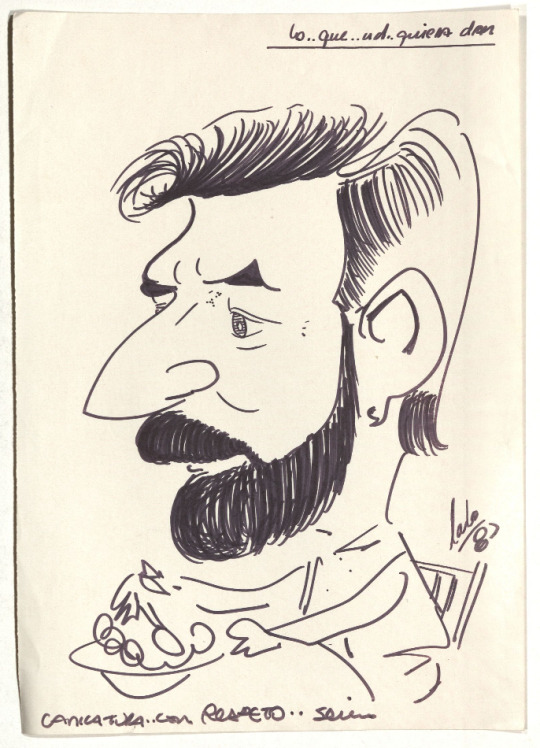
Image: Caricature drawing of Hahn from the Oscar Hahn Papers
In Special Collections and Archives, we have the Oscar Hahn Papers, containing a fairly complete list of Hahn’s publications and materials about him as well some published works in the monograph collection. A link to the collection finding aid can be found here.
-Kaylee S., Special Collections, Olson Graduate Assistant.
#uiowa#special collections#uiowaspecialcollections#voicesfromthestacks#library#poetry#chilean poetry#chile#oscar hahn
25 notes
·
View notes
Text
#VoicesFromTheStacks
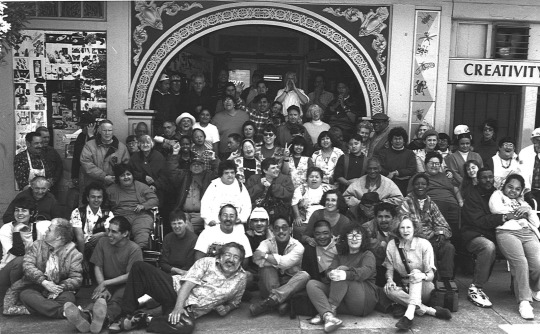
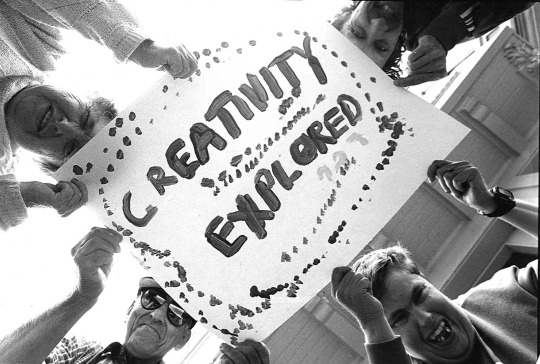
Images: Left, Photo of Creativity Explored community in front of entrance. Right, Creativity Explored artists Ruthie Freeland, Eddie Hippley, Michelle Kunard, and Vernon Streeter (counter clockwise from top left)
Creativity Explored
Founded in 1983 by Florence and Elias Katz, Creativity Explored, a studio-based collective in San Francisco, sought to create a space which fosters the creative expression of artists with disabilities. Creativity Explored has supported the careers of hundreds of artists since its foundation through means of training, offering supplies and resources as well as exhibition and sales opportunities. With the belief of centering the personhood and agency of the artists within the collective, the voice of disabled artists has come to the forefront through their work.
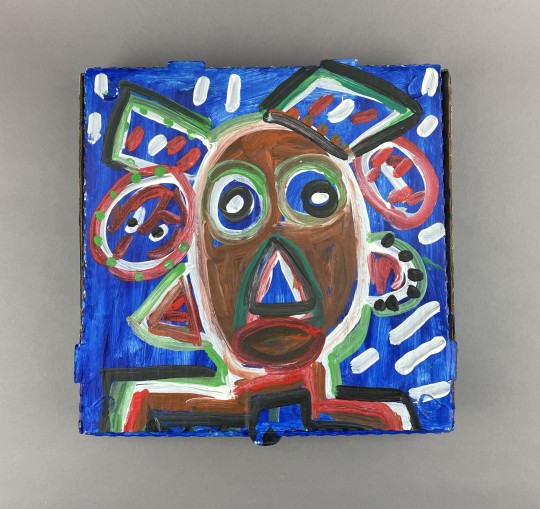
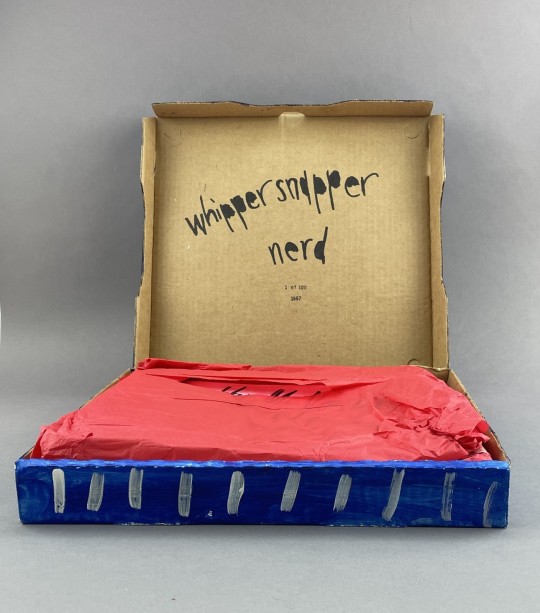
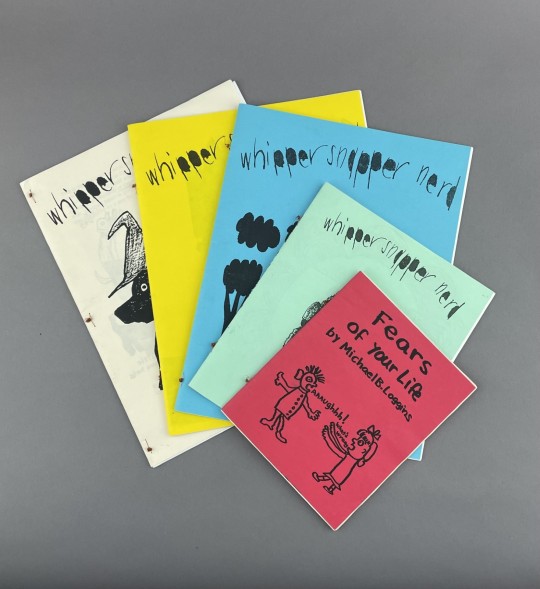
Images: Cover, inside and zines from the Whipper Snapper Nerd first edition held in UIowa Special Collections.
In 1994, two volunteers at Creativity Explored – Harrell Fletcher and Elizabeth Meyer – began collaborating on a zine series titled Whipper Snapper Nerd. Each issue of the series has been devoted to the work of one artist from Creativity Explored and includes reproductions of their work and an interview. Here in the Ruth and Marvin Sackner Archive housed in Special Collections and Archives, we are fortunate to have the first copy of a limited edition set of Whipper Snapper Nerd. Included in the collection are the first four issues of the series centered on artists Barbara Doehrman, John Patrick McKenzie, Jimmy Miles, and Michael B. Loggins. Due to the relationship Ruth and Marvin Sackner had formed with Creativity Explored, this first edition of the collection also included additional pieces from artist John McKenzie and another zine from Michael B. Loggins.
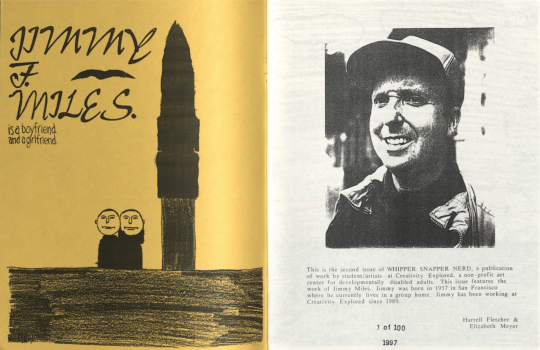

Images: Left, inside front cover of zine featuring the art and photo of Jimmy Miles. Right, inside front cover of zine featuring the art and photo of Michael Loggins.
A true highlight of each issue of Whipper Snapper Nerd are the interviews between each artist with either Fletcher or Meyer. Through these interviews readers get an insight into the interests, beliefs, and processes each artist has that translates into their work. Here the artists discuss their experience creating at Creativity Explored as well as any topic that should come up. The artists are honest, poignant, funny, and at times even blunt – it is fantastic. We learn that Barbara loves The Brady Bunch and cats. Jimmy doesn’t like questions, but he does love drawing planes. Michael loves hearing people laugh and has found the perfect jokes to tell his girlfriend Hope. John doesn’t like Linda Ronstadt or John Lennon but loves Curious George.
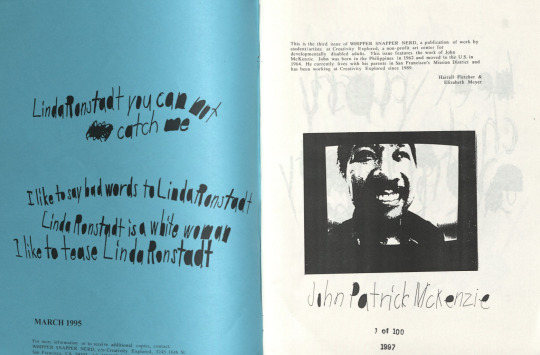
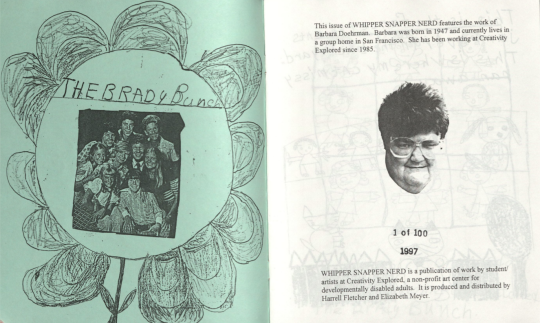
Images: Left, inside front cover of zine featuring art and photo of John Patrick McKenzie. Right, inside front cover of zine featuring art and photo of Barbara Doehrman.
Outlets like Creativity Explored are invaluable to a community which has been underrepresented and invalidated. Art is a universal language and allows freedom of expression and creativity that holds special importance for those with intellectual or developmental disabilities. Creating a similar space for disabled artists locally, Systems Unlimited, developed an arts center to promote radical inclusion through art in Eastern Iowa. Here, artists are supported and empowered to contribute to a creative community not only in Iowa but beyond.
Did you know?
Up to 1 in 4 (27%) adults in the United States have some type of disability
More than half of all adults with both cognitive and mobility disabilities reported mental destress
Engaging with art has been found to increase psychological health, boost self-esteem, reduce PTSD symptoms, and enhance communication skills.
At the University of Iowa, we also have services at the student level [UI Students for Disability Advocacy & Awareness (UISDAA)] and institutional level [Student Disability Services (SDS)].
-Kaylee S., Special Collections, Olson Graduate Assistant.
#uiowa#special collections#uiowaspecialcollections#voicesfromthestacks#creativityexplored#disability awareness#disability rights
19 notes
·
View notes
Text
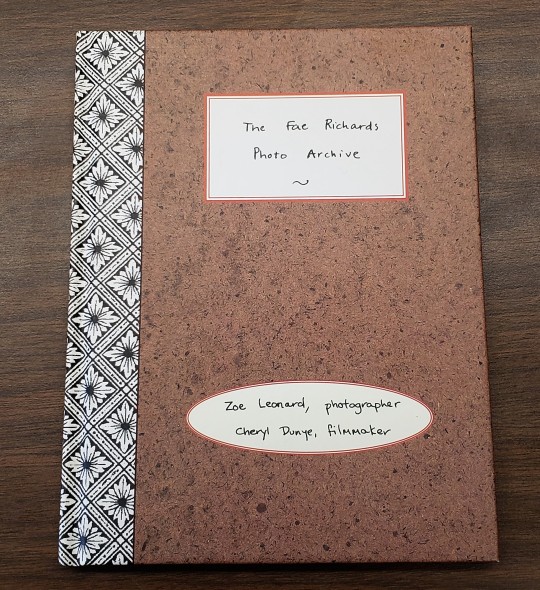


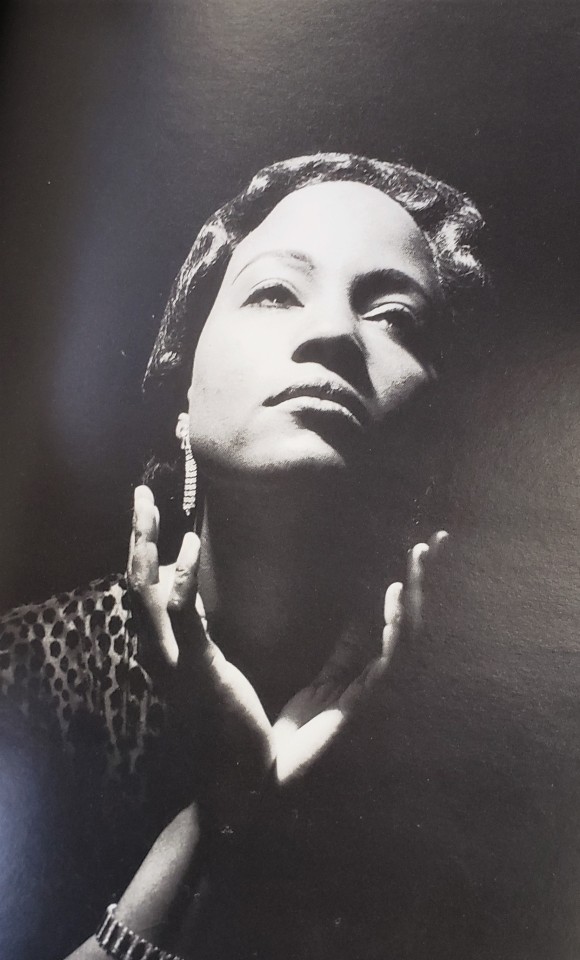
Past and Present: Cheryl Dunye’s The Watermelon Woman
Last year, Special Collections and Archives at the University of Iowa Libraries acquired items to form a new collection: the Black Film and Television Collection. In honor of Black History Month, we’re shining a spotlight on a different item from this collection each week.
In yesterday’s post, we discussed the original script for 1971’s Shaft, a defining entry in the Blaxploitation genre. Our final spotlight shines on a unique photo book from 1996, when Cheryl Dunye’s The Watermelon Woman attempted to excavate the history of queer Black women on screen.
Cheryl Dunye and New Queer Cinema
With The Watermelon Woman, Dunye became the first Black lesbian to direct a feature film. This movie belongs to a genre that came to be called New Queer Cinema, a movement in independent film during the 1990s that placed queer characters at the center.
The film was critically acclaimed and regarded as one of the foundational films of the genre, and it was added to the Library of Congress’ National Film Registry in 2021.
It also gave new momentum to Dunye’s career in film and television, which continues to this day. Her recent directing credits include The Umbrella Academy, Bridgerton, and Queen Sugar.
Unnamed & Uncredited
The Watermelon Woman stars writer and director Cheryl Dunye as an aspiring documentarian who works at a video rental store. Dunye’s fictional proxy, also named Cheryl, is fascinated by the history of Black women in film, particularly those who went unnamed and uncredited for roles portraying the racist archetypes that were common in the cinema of the 1930s and 40s.
In the movie, Cheryl embarks on a journey to discover the name of Black actress only identified as “The Watermelon Woman.” She eventually uncovers the woman’s real name, Fae Richards, and discovers that she, too, was a queer woman.
A Supplementary Archive
Fae Richards may be a fictional character, but she stands for countless queer Black people whose stories have been omitted from the record. Artist Zoe Leonard, in collaboration with Cheryl Dunye, created The Fae Richards Photo Archive, a series of 82 images that document the life of this fictional character. From candid shots, family photos, and publicity pictures, every image matches a time and place of this character. As the Whitney Museum of American Art explains, “Leonard acknowledges the project’s artifice, encouraging the viewer to recognize that she had to create a story that is fictional, but rings true, because the real life counterparts of such stories went undocumented.”
This statement demonstrates exactly why many archives are, or need to, work to fix the mistakes of the past. As a school with a rich screenwriting history, it is why the University of Iowa Libraries is actively working to collect more stories from Black cinema.
A Century of Black Film
During this series, we’ve looked at four iconic examples of Black filmmaking. But that’s not to say that the work of Black filmmakers can be reduced to four eras, or that the films we discussed are more important than those that didn’t make this list. There’s so much more to discover in the Black Film and Television Collection, and if you’ve enjoyed this blog series, we encourage you to check out what’s available online. As The Watermelon Woman attests, the preservation of these stories, and the names and lives behind them, is vital and rewarding work.
--Natalee Dawson, Communication Coordinator at UIowa Libraries, with assistance from Liz Riordan, Anne Bassett, and Jerome Kirby
#watermelon woman#libraries#blackhistorymonth#black film#uiowaspecialcollections#film#uiowa#black history matters#Cheryl Dunye#Zoe Leonard#Fae Richards
128 notes
·
View notes
Text




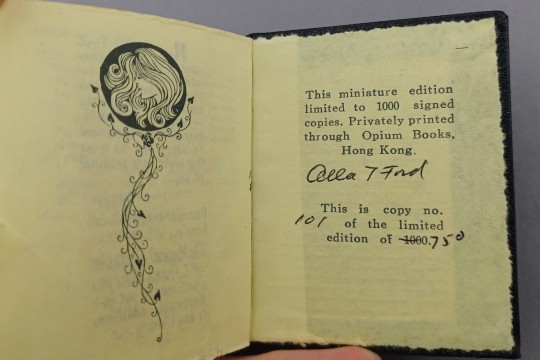
#MiniatureMonday
#HollywoodExhibit
The musical fantasies of L. Frank Baum by Alla T. Ford and Dick Martin. With 3 unpublished scenarios by the author of The wizard of Oz.
Did you know that L. Frank Baum started out his career doing traveling plays and musicals? This book talks about his early life and career that lead up to his most popular book The Wizard of Oz.
It also talks about some of his unpublished works, like The Maid of Athens, The King of Gee-Whiz, and The Pipes O'Pan. This tiny book by Alla T. Ford and Dick Martin also includes lovely line drawings on its light yellow paper throughout.
This is part of a continuing series featuring minis in conjunction with the of the new Hollywood Exhibit that is now up in the reading room.
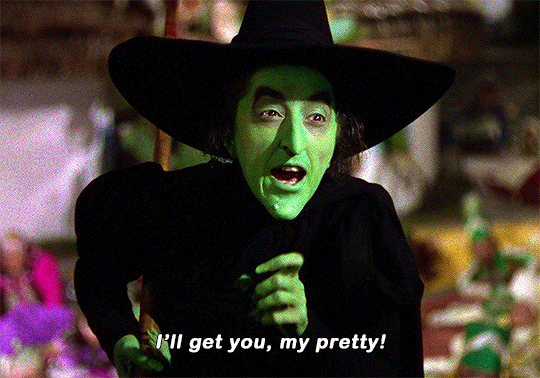
"And you will never join your friends to visit the exhibit! *Evil cackle* "
--Diane R., Special Collections Graduate Student
#Uiowa#UiowaSpecialCollections#Exhibit#L.FrankBaum#Alla T. Ford#Dick Martin#The Musical Fantasies of L. Frank Baum#The Wizard of Oz#MiniatureMonday
46 notes
·
View notes
Text
#VoicesFromTheStacks

Photo from ursulakleguin.com
Ursula K. Le Guin was an American science fiction and speculative fiction author. She was born Ursula Krober in Berkeley, California on October 21st, 1929. She died on January 22nd, 2018, at the age of 88.
Her father was an anthropologist and her mother had a graduate degree in psychology. Le Guin and her three brothers had access to a large library. She read early science fiction and fantasy books and magazines as a child, including Astounding Science Fiction and Thrilling Wonder Stories, issues of which can be found in the Special Collections and Archives Rusty Hevelin collection.

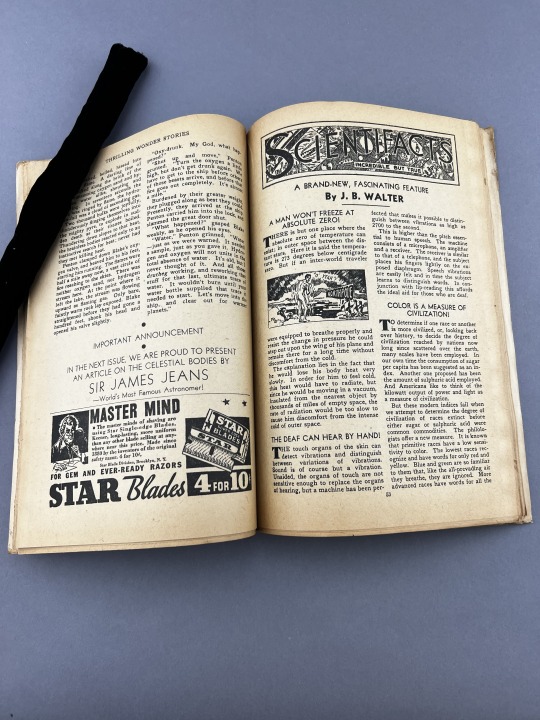
She would publish her first work, a poem titled “Folksong from the Montayna Province”, in 1959. Her published work included poetry, short fiction, novels and nonfiction essays. Her book The Left Hand of Darkness would garner her critical and popular success, making her one of the first well-known female science fiction and fantasy authors, and one of the most famous science fiction authors, period.
During her career, Le Guin was primarily known for her speculative fiction work, notably her Hanish Cycle and Earthsea series. The Hanish Cycle posits a universe where humans have formed an interplanetary alliance. Her most famous Hanish book was The Left Hand Of Darkness, considered one of the first works of feminist science fiction, and deals largely with gender, sexuality, and politics. Her Earthsea books are considered classics within the children's fantasy genre.
Le Guin's influence as a fantasy and science fiction author is still felt today, she was a noted influence on writers like Neil Gaiman and Salman Rushdie, and is considered to have been the first writer to create a "wizard school" with her Earthsea series.
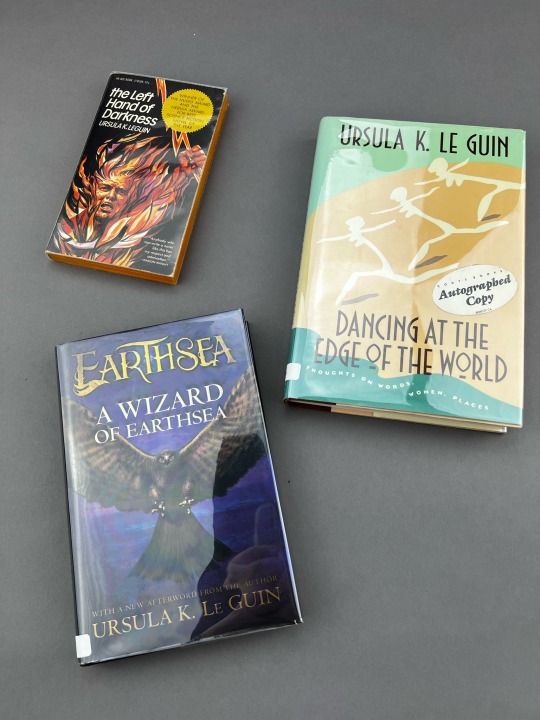

Special Collections has copies of many of Le Guin's writings, including signed copies.
-- Sarah D., Special Collections, Olson Graduate Assistant
#special collections#uiowa#voicesfromthestacks#uiowaspecialcollections#libraries#ursula k. le guin#science fiction#speculative fiction#fantasy
121 notes
·
View notes
Text
#Voicesfromthestacks





What does it mean to de-colonize a meal?
Sean Sherman -- an Oglala Lakota chef born on the Pine Ridge Reservation in South Dakota and the founder of The Sioux Chef, focuses his culinary skills on the “revitalization and awareness of Indigenous foods systems in a modern culinary context.” Sherman took it upon himself to study the foundations of the food systems particular to the local Dakota and Ojibwe tribes, gaining knowledge of Indigenous farming techniques, land stewardship, hunting and fishing, salt and sugar making, the usage of wild food and harvesting, food preservation, elemental cooking techniques, Native American migration history, and Native American Culture and history in a more general sense to get a more holistic understanding of Native American cuisine and how to bring that back in the present.
The Sioux Chef’s Indigenous Kitchen is an introduction into modern indigenous cuisine of the Minnesota and Dakota territories. The recipes are all focused and centered around ingredients indigenous to America. No European staples like dairy products, sugar, or domestic pork. Instead, there’s duck, venison, blueberries and wildflowers to name a few.
In his introduction, Sherman states “This book is about the joy of indigenous cooking. It reveals the delight in finding ingredients right outside our kitchen doors. … These recipes, inspired by methods handed down through the ages, generation after generation, are integral to our culture, and, as with all good recipes, the dishes will change from cook to cook. These recipes are meant to be guidelines, not formulas. … These recipes along with the stories of goodness and resilience are told with hope and joy.”
-Matrice Y, Special Collections, Olson Graduate Assistant
#special collections#uiowa#voicesfromthestacks#uiowaspecialcollections#libraries#cooking#native foods#Sean Sherman#indigenous#szathmary#Cooks of Color
643 notes
·
View notes
Text

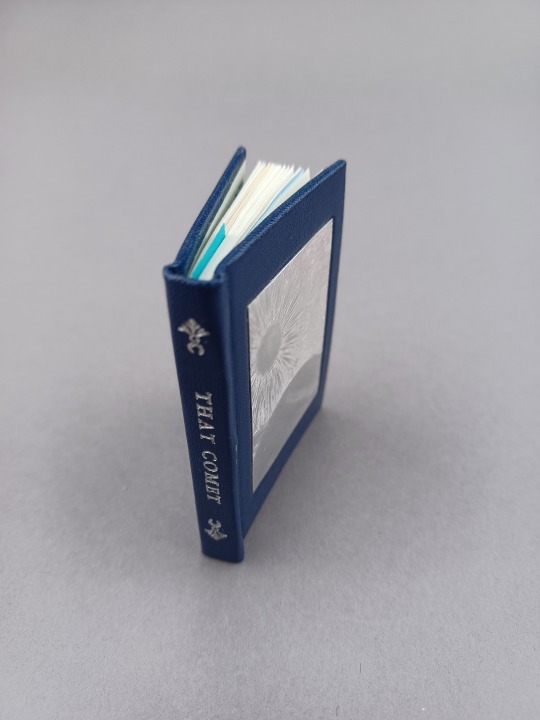



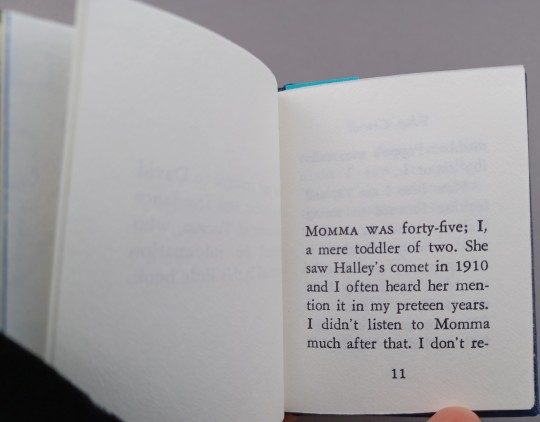

#MiniatureMonday
That comet / Esther K. Beamer
Halley's comet will not be visible again until 2061, but we have this pretty little book to tide us over until then!
It features a bright silver plate on the cover, dark blue covers with a silver title, and lovely blue illustrations. It features a short history of the comet, as well as a bit of personal history from the author.

Even if this comet is not visible, winter here in Iowa is a great time to go stargazing! Maybe you will see a shooting star.
--Diane R., Special Collections Graduate Student
#Uiowa#UiowaSpecialCollections#MiniatureMonday#Halley'sComet#That Comet#Esther K. Beamer#Desert Press#Tabula Rasa Press#astronomy
62 notes
·
View notes
Text
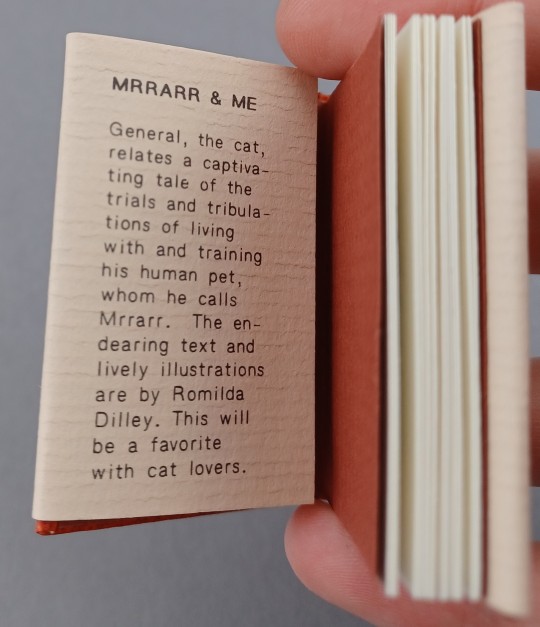


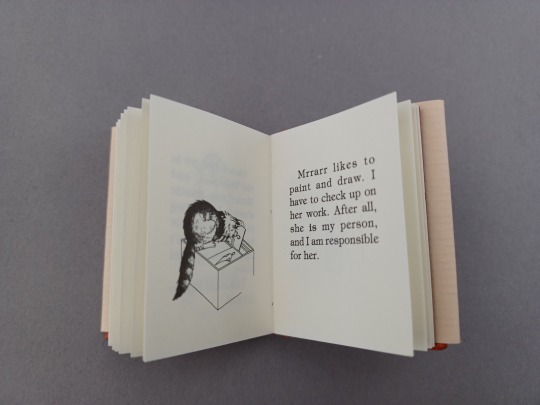
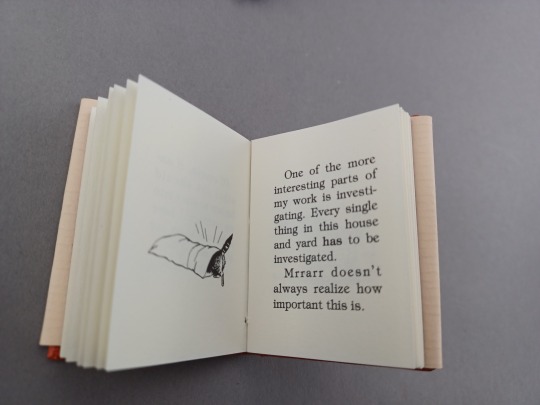
#MiniatureMonday
#TaleOfTalesExhibit
Mrrarr and me / written and illustrated by Romilda Dilley.
Any cat owners out there sometimes feel that your cat thinks they are the ones actually in charge?
This fun book is based on that concept, written from the perspective of cat named General about his responsibilities around "his" house and person, whom he calls 'Mrrar". These include making sure she gets up suitably early, 'helping' with the lawn work, and inspecting everything.
This is particularly important, as General says "Every single thing in this house and yard has to be investigated. Mrrarr doesn't always realize how important this is."
This is part of a continuing series featuring pet minis in conjunction with the of the new pet themed exhibit that is now up in the reading room. This particular item is from the corresponding mini exhibit, put together by Rachel, so make sure to take time to see that wonderful collection as well, for more fun finds like this!
--Diane R., Special Collections Graduate Student
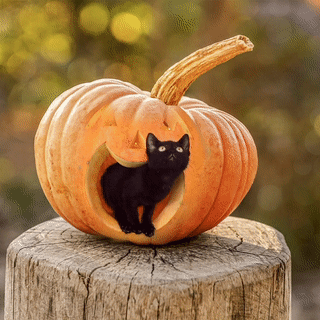
^"Don't worry human, I have inspected the pumpkin, and it is safe from any foul Halloween creatures! You can go visit the exhibit now. Say 'Hello' to the Hawkeye Ghost for me!"
#Uiowa#UIowaSpecialCollections#Pets#Exhibit#MiniatureMonday#Cats#CatBook#Mrrarr and me#Romilda Dilley
122 notes
·
View notes